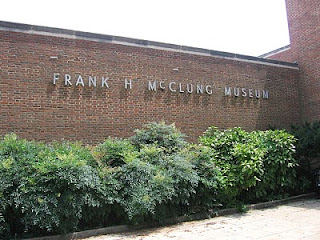
The McClung Museum is located on the University of Tennessee Knoxville campus. It is open 9 to 5, Monday through Saturday and 1 to 5 on Sundays. Admission is free. Their
website is excellent and you can
view the permanent exhibits online if you can't make it to this museum. The statue leading up to the museum was interesting, but on the day I went alone, the landscaping could use some tending to.


There is a wide variety of exhibits at the McClung. Archaeology & the Native Peoples of Tennessee is one of my favorite museum exhibits. The exhibit is set up so you can casually look through it or spend hours in it. There is quite a bit of information contained in the exhibit without it being overwhelming to the casual museum goer. The entire room is designed to make you look around, with displays underfoot and grand paintings adorning the walls.
The exhibit is designed to lead you around the outside of the room, but many people miss the interactive displays in the middle. As someone who is considering teaching anthropology, I especially enjoyed the display where you guess what something is from a piece of, making people think about the way field archeologists have to think about the items they find.
The small theater in the back was a good size for the space and the video was okay. An exceptional piece in the exhibit was the canoe and the designer of the space presented it in a way that didn't overwhelm but still showed the entire thing. The Duck River Cache is simply amazing and such an important find it could almost be it's own exhibit.





The Egyptian exhibit is nice and shows a wide variety of artifacts, both actual and copies. The Hypostyle Hall model is very striking and draws the eye. Copies help fill out the collection, however, a notice on why there are models and copies rather than originals might help with public perception on the exhibit. One of my favorite items in the collection was a small aqua-colored hippo. I also enjoyed the palettes used for crushing cosmetics.




On temporary display was my least favorite exhibit in the museum, the one on shells. I thought using the same bland blue for the backing of each case with the same lighting was very bland, though I can understand that money can be a problem with mounting temporary displays in an interesting manner. The Freshwater Mussel exhibit had some of the same problems.
Downstairs, in addition to the mussel display, there is the Battle for Fort Sanders display, which is a little dated, but ties in with the local area excellently. The Human Origins exhibit is good, though as an anthropology major, I've had to look at it multiple times, so it's lost some of the the luster. I enjoy the mural on the ceiling every time I'm there.
All in all, the McClung is definitely worth the visit even if you don't live on campus. Parking in Circle Park is free for 45 minutes, which is plenty of time for a casual stroll though the entire museum or a more detailed-oriented visit to one of the individual exhibits.



 After visiting the UT Downtown Gallery, Mike Berry showed us the Emporium Building next door. It holds an emporium worth of artists and organizations. After visiting our host's studio, I wandered the balcony upstairs, looking at what some local artists are creating today.
After visiting the UT Downtown Gallery, Mike Berry showed us the Emporium Building next door. It holds an emporium worth of artists and organizations. After visiting our host's studio, I wandered the balcony upstairs, looking at what some local artists are creating today. 






















































